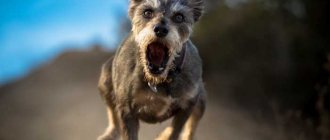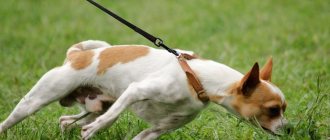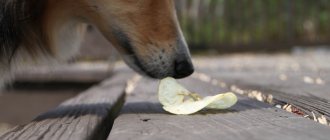A warning growl from an animal guarding the territory or person entrusted to it is completely justified and even commendable. But if similar behavior appears in relation to one’s own owner, then it is worth seriously thinking about its reasons. Understanding what to do when a dog is aggressive is quite difficult - sometimes you have to contact a dog handler or veterinarian to solve the problem.
Common Causes of Aggressive Behavior
There are many possible causes of aggression in dogs, but the most common ones can be divided into 3 large groups. These include:
- Selection errors
. Violation of established rules and thoughtless crossing of incompatible breeds with various deviations lead to the creation of individuals with completely unpredictable behavior.
- Miseducation
. Lack of timely socialization and good training, as well as too many concessions can lead to unpleasant consequences. A pet that does not feel the authority of the owner and does not know how to communicate with the outside world becomes uncontrollable.
- Bad content
. Life in an enclosure or on a leash, excluding communication with other animals and people, has a negative impact on the psyche. Cruel physical punishments applied for any offense have a similar effect.
Most often, there is a human factor behind aggressive behavior. Mistakes made by the owner can lead to dangerous events. The owner's own children, neighbors and other pets who are unable to fight back can suffer from the aggressor.
Who can a dog lunge at?
In addition to a direct attack, a warning growl and bared teeth, aggressiveness can be manifested by disobedience. The dog refuses to follow commands or does not allow the owner near his toys. Remember that any uncontrolled behavior is abnormal and requires correction.
On the owner
Dog aggression towards its owner is most often associated with improper upbringing or pain. In the second case, a negative reaction may occur while cleaning the ears or combing the fur. But if an animal attacks you for accidentally pulling out a hair, then such antics require mandatory correction.
Young children are more vulnerable and may become victims of redirected aggression. It occurs in animals that are encouraged to attack other pets. Never allow such behavior for fun, since the bully you brought up will sooner or later choose one of the family members as an object of attack - perhaps a child or a fragile woman.
On other people
A similar reaction is typical for service, guard, fighting and hunting breeds. They have a genetic distrust of strangers, so if their territory or property is encroached upon, they immediately attack the intruder.
On other animals
Dogs with poor socialization, strong territorial instincts, or dominant behavior often attack other animals. In addition to neighbors' dogs, they can also harm those who live in the same house with them.
A terrible incident
Late last year, Bethany Lynn Stevens was found dead in the woods. The body of the 22-year-old owner was “guarded” by her pit bulls. According to the police officers who discovered the discovery, the body showed the usual bite marks and was all torn apart in a horrific manner. And both dogs continued to eat it right in front of the police.
The family and friends of the deceased could not believe what had happened. Bethany adopted the dogs as small puppies. According to friends, the dogs were very kind and affectionate.
There can be many reasons why dogs may attack their owners. According to experts, there is no exact way to help determine the cause of the attack caused.
Schoolchildren from India have created a completely safe substitute for plaster crayons
New cartoon “Ogonyok-Ognivo”: starring Natalya Tereshkova and Pyotr Kovrizhnykh
Can your cat do this? New pictures of cats from all over the world
Types of aggression in dogs and methods for eliminating them
Not only the reasons and objects of attacks differ, but also the signs of hostility. Based on these criteria, 11 types of aggression are identified, eliminated by different methods.
Territorial
Often found in fighting and guard breeds due to their developed territorial and protective instincts. To adequately perceive the situation, such animals must be trained from puppyhood. Otherwise, they will attack not only real violators, but also:
- cats walking along the fence;
- neighbors who came to exchange a few words on your property;
- unexpectedly arriving friends;
- any people appearing outside the window.
If the aggressor calms down when he is not on his territory, learn security commands (“Voice”, “Guard”, “Stranger”). With their help, you will avoid empty barking at passing cars and teach you to protect entrusted items only with your permission. If you can’t cope on your own, sign up for ZKS courses.
Possessive
It manifests itself in a reluctance to give away toys or other objects that the dog considers his own. This is typical for animals that are accustomed to playing tug-of-war and do not perceive the authority of the owner.
Corrected through proper education. Stop attempts to assassinate the main role even in the game. Give out toys when you see fit, and be sure to stop playing if your pet starts growling at you. At such moments, the dog must be left alone, since ignoring is the most effective way of punishment.
Be sure to learn the “Fu” and “No” commands. They will help control the actions of your four-legged friend at home and on walks, eliminating unwanted guarding of toys or eating dangerous objects.
Dominant
Dominance manifests itself in ignoring commands, attacking a person and making independent decisions on any issues. The cause of dissatisfaction may be a ban on sleeping in the wrong place, combing the fur, pulling on the leash, staring, screaming or the use of physical force. Such actions are perceived as a demonstration of superiority, so a pet that disagrees with your authority will try to challenge the place of leader in its favor.
It is necessary to prove your leadership in your own home from the first days of the appearance of your four-legged friend. It is much easier to explain your superiority to a puppy, so try not to miss this moment. Set the desired prohibitions and never make concessions when they are violated. If your dog should not sleep in the same bed with you, do not allow him to do this even during illness.
Please note that the pet must unquestioningly follow the commands of all family members. Don't let him dominate the children, but don't physically punish them for disobedience either. This will only worsen the existing situation.
Discourage hand biting during play. This could result in some pretty serious injuries in the future. If you disobey, try to switch the aggressor’s attention by commanding “Sit” or “Lie down.”
Predatory
A developed hunting instinct forces one to pursue moving objects that suddenly appear in the field of view: running children, cyclists, cars, cats, rodents or birds. At such moments, the dog completely gives in to the chase, losing touch with the outside world. A four-legged pet keen on hunting can not only get lost, but also cause quite serious injuries to its target.
To prevent negative consequences, it is necessary to take your four-legged friend to special obedience courses. After this, unwanted actions can be stopped with the commands “Fu”, “Come to me” or “Lie down”, accompanied by a sharp pull on the leash.
Food
Food aggression in dogs is expressed by a warning growl at people or other pets trying to approach a bowl of food. Fearing for the safety of its “prey,” the animal may hastily swallow food or attack a competitor.
To solve the problem, it is necessary to change the feeding regimen, eliminating extraneous irritants. Feed your pet alone, do not let him bite and give treats only for real merit. Try the following exercise:
- Before serving food, give the command “Sit”.
- Then place the bowl and command “Wait”, not allowing you to touch the food until you receive the appropriate permission (“It’s OK”).
- After a while, interrupt the feeding by commanding “No” or “Wait.”
- Wait a few seconds and allow him to eat again.
If the exercise is successfully completed, praise your pet and give him a treat. If you fail, take the bowl and command “Place.” Repeat the previous steps regularly until the unwanted behavior disappears.
Protective
Characteristic of guard and service breeds that protect the thing or person entrusted to them. In the absence of a real threat, such a reaction is inadequate.
It is better to learn guard and protective service under the guidance of a dog handler. It is enough for the owner himself to prevent these actions with the help of timely socialization. Do not lock your dog alone in an enclosure and give him the opportunity to socialize with your friends and acquaintances to reduce existing anxiety. Encourage negative reactions to strangers only if they can really harm you.
Maternal
Protection of offspring is a natural reaction that occurs during bearing and feeding puppies. Most often it occurs in females, but sometimes it is also observed in males who protect the “nest” from the encroachment of potential enemies.
It is impossible to eliminate this type. It passes without outside help when the kids gain independence. It is enough for the owner to help secure the location of the “nest” and avoid provocations from the anxious mother.
Painful or fearful
Characteristic of insecure or abused animals. If your pet growls, bites his hands and hides in a corner during grooming or when he sees strangers, use sedatives and engage in socialization.
Ask your friends to come up to you on the street and give your dog a treat. Several such meetings will calm the four-legged aggressor and reduce existing anxiety. The treat can also be given after a haircut to create a pleasant association with the frightening procedure.
Separately, it is worth noting the pain caused by internal pathologies. If growling and grinning occur when trying to touch the belly, paws or other parts of the body, be sure to make an appointment with a veterinarian for diagnosis.
Intraspecific
It is most often observed between same-sex individuals shortly after puberty. The targets of attacks are weaker animals that are unable to stand up for themselves. The aggressor does not allow them to eat until the end of their own meal, takes away their toys, and does not allow them on the bed or in the room.
To suppress hostility, castration and sedatives will be required. Also, we must not forget about gradual socialization. Walk your rebel on a leash, stopping and punishing attempts to attack other animals.
During sexual heat
A surge in hormones is observed not only during pregnancy, but also during sexual intercourse. The female becomes aggressive shortly before ovulation and immediately after it ends. The male's aggressiveness lasts longer and is explained by the protection of the chosen one from possible competitors.
The most effective way to eliminate this species is castration. Thanks to the removal of the reproductive organs, the hormonal levels are stabilized, eliminating new outbursts of anger.
With breeding animals you will just have to wait out this stage. To protect others, be sure to put a muzzle and leash on your pet to prevent attacks and fights.
Unmotivated
The unmotivated appearance has no reason and occurs spontaneously due to mental deviation. A similar reaction is typical for individuals born as a result of violation of selection rules.
Such cases are rare and require the mandatory intervention of a veterinarian. It is impossible to correct the situation on your own.
Insufficient care
According to scientists, dogs usually do not try to eat torn bodies. Such atrocities can be explained by severe hunger. If the dogs were poorly fed and did not receive enough food, this could provoke such dire consequences.
In this case, this is exactly what happened. Bethany, who had previously babysat her dogs like children, was in the process of getting a divorce. She didn't have time to take care of the dogs, so she gave them to her father. The man put the animals in a cage, where they were isolated from others. The only people they saw were their mistress, and not every day. The woman's father did not consider himself obligated to feed the animals, so the dogs did not receive daily nutrition and often went hungry.
WHO: the second year of the coronavirus pandemic may be more difficult
The cat loves his new scratching post-bed: we make it in a very simple way
For eight years now, Rodion Gazmanov has been living with his faithful friend, the cat Sheldon: photo
According to experts, the dogs could not have attacked their prey at the same time. First, one showed aggression, and the second joined in. There is a possibility that their behavior could have previously shown signs of aggression, which the owners simply did not notice.
What should the owner do?
If a dog has become aggressive, how to deal with the hostility will depend on the cause. You can resolve the situation yourself or seek help from a dog handler. The help of a veterinarian will be needed only in the most extreme cases, when aggressiveness is explained by pain due to illness or is unmotivated.
Solving the problem yourself
If hostility is not innate and is caused by a certain factor, then in most cases it can be eliminated on your own. To do this, it is necessary to eliminate equality or suppress the authority of the dominant pet. The position you take should correspond to the leader of the pack or an adult animal that commands respect from the young.
Proper upbringing excludes any violence. It undermines trust and strengthens fear, increasing the aggressor's anger.
First, eliminate all irritating factors and start teaching your pet basic commands. Reward for success, but do not give in to provocations. When attempting to attack or growling in displeasure, use distraction or ignore.
Engage in socialization: put protective gear on your pet and go to walking areas popular among dog lovers. When meeting other animals, control the reactions of your four-legged friend, explaining the difference between a real and an imaginary threat.
Appeal to the dog handler
If your attempts do not bring results, sign up for courses at a kennel club. Depending on the situation, you will be offered group or individual classes, where your four-legged friend will be taught manners and rules of behavior in society. Dog handlers recommend taking the UGS and OKD courses together with your pet, as this strengthens the bond with the owner.
Contacting a veterinarian
The painful type of embitterment associated with internal pathology goes away on its own after treatment. Also, the help of a doctor may be needed to reduce increased anxiety and suppress sexual desire. In the first case, the four-legged patient will be given sedatives, and in the second, castration or sterilization will be offered.
It is better to avoid taking hormonal drugs. They have too many side effects, including a high risk of developing cancer. Surgical deprivation of reproductive function is much safer and more effective.
The unmotivated type of anger deserves special attention. It cannot be treated, so the main goal of therapy is to maintain remission with the help of medications and sessions with a zoopsychologist.
In most cases, the owner himself is to blame for the pet’s aggressiveness. Any pet requires socialization and training. If you are not confident in your own abilities, do not undertake raising a wayward breed that has a tendency towards aggression at the genetic level.
Remember that it is much easier to deal with a disobedient dog at an early age. Do not put off learning commands for the future and instill in your pet the rules of decency from the first days of his arrival in the house.
The article is of a recommendatory nature. Contact a specialist!
Why dogs attack - and what to do if you have already been bitten
A dog always remains an animal - it lives at home or on the street, it lies on the sofa, sits on a chain or runs wherever it pleases. If you forget about this, you can become a victim of aggression on her part. This, unfortunately, is not uncommon, and situations vary. Let's take a closer look at them.
SITUATION: a child wants to pet someone else's dog
A dog always protects its own, and allows a member of its “pack” (including humans) to do things that it does not allow others. If there is a stranger in front of it, any dog can attack if it feels a danger to itself, to “its own” or to its territory. Unfortunately, we don’t know what and when the dog will consider dangerous. Therefore, do not touch other people's dogs, even domestic ones, without the owner's permission and do not allow children. This is especially true when trying to pet puppies in front of their mother.
SITUATION: There are dogs where you walk
If this is a pack's territory, you may have problems: the dogs are watching for strangers crossing their property, and the situation becomes tense, for example, if there are puppies somewhere nearby. It is better, of course, to change the route. If this is not possible, try not to walk this road alone: when a dog sees company, the risk of attack is lower, since its animals also perceive it as a pack. Arming yourself with a stick, unfortunately, is rather pointless - not every dog can be frightened like that, but a pack even more so; even a single dog can be provoked by it.
SITUATION: A stray dog notices you and follows you
Don't run. A running person evokes hunting excitement in a dog - he seems like prey that can and should be defeated. And don't turn your back. Stop, stand facing the dog and look into the eyes. This will make her doubt whether she should get involved with you. If she moves away, you need to move in the same way, with your back, without taking your eyes off the dog.
SITUATION: the dog shows interest in you, but without aggression
What should you do if he looks at you, tries to sniff you, or stays close to you? It's better not to pay attention to it. If you try to speak “kindly”, extend your hand, this can provoke fear and, again, aggression - the dog will start barking, jump away, other members of the pack will be “turned on”, and no one knows how it will all end. It is better to remain independent, try to pass by as quickly as possible and do everything possible not to encounter these dogs again.
SITUATION: you were bitten after all
Wash the bite area with regular tap water and soap. Do this even if the bite was through clothing. Treat the wound (even if it's just a scratch!) with an antiseptic, preferably water.
Contact the emergency room if the dog is street or domestic, but you could not find the owner. If he is known, ask about the animal’s vaccinations. If it is not vaccinated against rabies, ask to update you on the dog's health status within 10 days. Lacerated wounds are also a reason to go to the emergency room.
Even if your wound was treated at the emergency room or it was small, and if the issue of the risk of rabies is closed, you need to monitor the site of the bite. Increased pain, swelling, redness, purulent discharge, increased body temperature, enlarged lymph nodes near the wound - all these are signs of infection and grounds for visiting a surgeon or infectious disease specialist.










